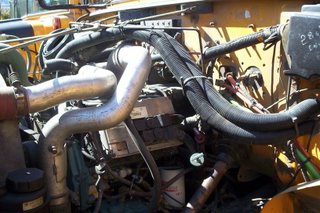Mechanical Repairs & Troubleshooting On Diesel Engines, School Buses and Related Operating Systems.
Tuesday, November 29, 2011
Mechanic Checks For Winter Operation
Coolant Testing the coolant is of course very important and changing the coolant and thermostats should also be considered. Cummins promotes DCA (dry chemical additive) checks, to make sure the system is not overcharged or undercharged. DCA prevents liner pitting by reducing air bubbles forming in the cooling jackets. Changing the coolant (non lifetime brands) with the thermostats every 2-3 years isn't a bad idea since coolant eventually breaks down and the acidic build up that forms starts to eat up gaskets and castings.
Belts and Hoses who doesn't know the importance of these bad boys. They get the most abuse from constant tension, heat produced from driving the belts and hot/cold temperatures on the hoses. I always say "when in doubt change it out". Pulley bearings and belt tensioners need to be checked out and the cooling system should be pressure tested. School buses have 1 inch cooling lines throughout the bus interior and need to be observed for leaks and loose clamps.
Batteries batteries can either be load tested once a year preferably in the fall or changed when needed. Sometimes the latter happens at the most inconvenient time when it's cold, wind blowing ....a spare bus (in my case) needs to be fired up from a cold condition. So we generally do the yearly load test and go from there deciding what step to take next.
Block Heaters Most buses in our fleet have the conventional block heater system. Our plug-ins are timed in cycles to come on during certain ambient temperatures. We test them at every service to stay on top of 'no start' conditions in the cold. A couple dozen of our newer buses have diesel heaters that have timers so they come on a couple of hours before the run.
Tune Ups Mechanics know the advantage of keeping an engine tuned up. Easier starts less fuel burned is the main objective. Valve sets, fuel filters and air filters are all you can really do to a diesel engine especially with newer models. Checking for engine codes doesn't hurt, some codes do not light up on the dash and become inactive. Common sense helps in this area of maintenance and needs to be applied looking at everything that makes a highway vehicle function. The regular Mechanic or the 'Mechanic in you' can figure this stuff out.
Thursday, August 04, 2011
International Diesel Engine Rebuild Installing Liners
Installing the liner is the next step.It's recommended to keep the liner seated firmly after installation as pictured here with metric fasteners and washers. The liner protrusion has to be checked as well to maintain a good seal surface for the head gasket. I hope this quick Mechanic information tidbit helped you out.
Monday, May 09, 2011
STN Going Social With Mechanic & School Bus Industry News
With changing technology it's essential to keep in contact with other professionals in the field and share ideas and answers to challenges encountered on a regular basis.
Here's the link if you want to check it out. I highly recommend this site for up to date knowledge and a free ticket to rub elbows with an experienced group of school bus mechanics willing to share their knowledge.
http://www.stnonline.com/social
Saturday, January 29, 2011
Cummins Diesel Engine Fuel Injection Pump Installation
 The Cummins Diesel [Engine Model 'C'] fuel injection pump has been repaired, but there are still a few steps to take.
The Cummins Diesel [Engine Model 'C'] fuel injection pump has been repaired, but there are still a few steps to take.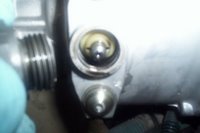
TIMING FUEL INJECTION PUMP:
The fuel injection pump MUST be timed by removing threaded hex cap located on the throttle shaft side of the housing. Remove timing pin from access hole and rotate the pump by hand until the timing tooth inside pump housing lines up with the middle of the access hole.
Engage slotted timing pin as the picture above shows. Install threaded cap hand tight until after injection pump is installed. The injection pump is now in the proper timed position.

PRE-LUBE INJECTION PUMP:
When a repair has been made on these pumps they must be pre-lubed with engine oil. Remove top plug from the governor housing with an Allen wrench. This particular model requires .71 Litres [24 oz.] . Failure to do this could cause damage during start-up.
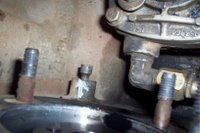

TIMING THE ENGINE:
The next step is to time the engine by rotating clockwise [viewed from the front] while pushing on timing pin until it engages into the camshaft gear. Engine is now properly timed, the fuel injection pump is ready to INSTALL.
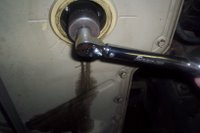 After the 4 mounting bolts are tightened, torque accessory drive gear retaining nut to 106 in. lbs. then DISENGAGE BOTH TIMING PINS. The injection pump timing pin just pulls out, flips around and stays installed on the pump for next time. The engine timing pin just pulls back and stays put.
After the 4 mounting bolts are tightened, torque accessory drive gear retaining nut to 106 in. lbs. then DISENGAGE BOTH TIMING PINS. The injection pump timing pin just pulls out, flips around and stays installed on the pump for next time. The engine timing pin just pulls back and stays put.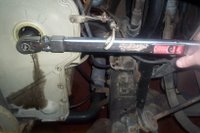
TORQUE DRIVE GEAR RETAINING NUT:
Now it's time for the final torque 144 ft. lbs. NOTE: torque specs will vary depending on the injection pump model. Now it probably makes sense to you why it's important to disengage both timing pins. They will sheer off very easily being made out of plastic and debris will get into the injection pump housing or engine timing gear housing.


BLEEDING THE FUEL INJECTION SYSTEM:
Once the lines, linkages and accessories have been assembled it's time to bleed the system. Loosen bleeder plug located on the engine side of the injection pump. Operate transfer pump by hand until all air has been bled out of bleeder plug. Tighten bleeder plug.
Crack as many injector lines as you can at each cylinder and crank over engine until there is evidence of fuel at each injector. Stop cranking and tighten injector lines, start cranking engine once again and before you know it you'll have a smokin' diesel engine!
Friday, December 31, 2010
Valve Adjustment On A DT466E International Diesel Engine
The DT 466E diesel engine is the electronic version of the former DT 466. This an engine we diesel mechanics all know and love since they are virtually almost bulletproof with a fantastic performance record. With emissions standards here to stay International has followed the other engine manufacturers and engineered electronic injection into their design.
The hardest part about working on these diesel engines is getting to the components, especially the valves if it's time for adjustment. The air to air piping has to be removed as well as the doghouse cover from inside the cab followed by the electronic control unit. These steps are required just to be able to reach the valve cover bolts.
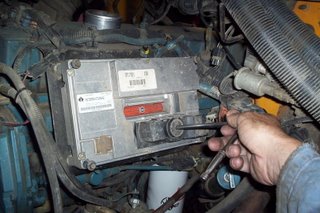 Remove the multi-pin connectors at the ECU [electronic control unit] with a 1/4 inch drive ratchet. Remove the round connector going into the valve cover housing.
Remove the multi-pin connectors at the ECU [electronic control unit] with a 1/4 inch drive ratchet. Remove the round connector going into the valve cover housing.
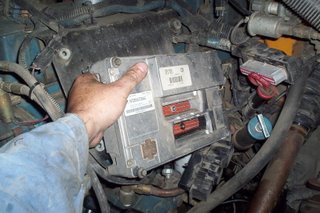 Remove the 4 bolts holding ECU to the support bracket using a 10 mm socket. Remove ECU and take care it's an expensive component!
Remove the 4 bolts holding ECU to the support bracket using a 10 mm socket. Remove ECU and take care it's an expensive component!
 Remove ECU support bracket, there is a larger fastener below bolted to the block and 4 valve cover studs at the top side where you have to remove four retaining nuts.
Remove ECU support bracket, there is a larger fastener below bolted to the block and 4 valve cover studs at the top side where you have to remove four retaining nuts.
 Push the ECU harness connector into the valve cover housing as it will stay with the injector wiring when removing cover.
Push the ECU harness connector into the valve cover housing as it will stay with the injector wiring when removing cover.
 Remove valve cover, the weight has increased drastically compared to the original non-electronic engines because of the integrated intake manifold that is now part of the valve cover.
Remove valve cover, the weight has increased drastically compared to the original non-electronic engines because of the integrated intake manifold that is now part of the valve cover.
 Rotate engine until TDC [top dead center] is achieved. There is a notch on the serpentine belt pulley behind the vibration dampner. An arrow and the letters TDC has been cast right into the front cover. Once lined up, the engine valves will be on #1 TDC compression or exhaust stroke.
Rotate engine until TDC [top dead center] is achieved. There is a notch on the serpentine belt pulley behind the vibration dampner. An arrow and the letters TDC has been cast right into the front cover. Once lined up, the engine valves will be on #1 TDC compression or exhaust stroke.
An easy way to tell is if #1 cylinder valves are both loose and #6 cylinder valves have no clearance, then you know you are on #1 compression stroke. Note: There are 12 valves in total #1 valve being at the front while #12 valve is the last valve at the rear of of the cylinder head.
So if I say adjust #4 valve you just count from the front of the head, the first valve being #1. This makes it easier to explain which valves to adjust.
On #1 TDC compression stroke adjust adjust valves #1 #2 #3 #6 #7 #10 . The valve clearance for both intake and exhaust is .025 in. preferably with the engine cold but that's not overly crucial.
Rotate engine 360 degrees the engine is now on #6 TDC compression stroke. Adjust #4 #5 #8 #9 #11 #12 valves.
 Once you have all the valves adjusted you reverse the disassembly procedure and torque the valve cover bolts to 13 ft. lbs. and the 1/4 drive wiring harness connectors at the ECU to 35 in. lbs. The valve cover gasket is reusable but still inspect it for damage or indications of wear.
Once you have all the valves adjusted you reverse the disassembly procedure and torque the valve cover bolts to 13 ft. lbs. and the 1/4 drive wiring harness connectors at the ECU to 35 in. lbs. The valve cover gasket is reusable but still inspect it for damage or indications of wear.
I hope this helps you out when it's time to adjust valves on your DT 466E Diesel Engine.
Diesel Mechanic
Tuesday, November 30, 2010
Mechanic 12 Volt System Troubleshooting-Reverse Warning System Stuck On
Below is what I call a 'Mechanic's Special'
The driver complaint is the back up alarm and reverse lights come on all the time even in neutral. So the first thing to think about is what could possibly cause this to happen without touching the controls. With the key on we have full operation of the back up warning system. The HDX Thomas pusher we are working on has the VIM (vehicle interface module) mounted above the steering axle (Lots of snow and ice). This is the first place to check since the interface module receives the reverse signal from the Trans ECU after the driver selects reverse. CLICK ON PICTURE TO ENLARGE.
The VIM has relays and fuses (BELOW) to control the circuits on the chassis side of the bus including the high idle, neutral start and reverse warning. Luckily once we pulled off the lid to the VIM we heard a buzzing noise. This is not normal and is a mechanic troubleshooting red flag, you want to look for abnormal mechanical situations.
After opening the VIM up the problem was obvious. The corrosion was making a circuit from battery to the reverse warning system. Moisture, oxygen and 12 Volt electrical circuits love each other and create double trouble after uniting for a given period of time.
Here is my 'KEEP IT SIMPLE' drawing (BELOW) of the circuit in question. The operator chooses reverse, the transmission shifts and the reverse signal is fed to the Vehicle Interface Module to the reverse relay and 12 Volt power feeds the reverse alarm and lights.
Once you know how a circuit works it makes the problem solving much easier and common sense will prevail. This problem can happen anywhere so be prepared. Checking electrical problem circuits and components closest to the environment pays off more times than not. I hope you got something out of this Mechanic Information.
Please leave a comment below and share any 12 volt electrical experiences you've had in the past or just let me know you got something out of this info.
Tuesday, November 23, 2010
Choosing A Mechanic Trade School Over College
Here's an interesting video on people enrolling into a trade school for a 10 month diesel engine training course instead of taking 4 years of college which comes with a much higher tuition. The enrollment fee is a fraction of what college costs and finding a job is faster and easier in the diesel engine mechanic trade.
Once you get your initial training at a trade school the chances of getting a job are much higher. Employers who want to hire a Mechanic for an apprenticeship like to find someone who has the basic training. Having a new kid on the block without any training means more supervision and less production.
Tuesday, November 16, 2010
Allison Transmission Codes & How To Retrieve Them
How To Retrieve an Allison Transmission Code
With the key on run... press the 2 arrows on your shift pad. You will get a D1 then 4 digits after that. The 4 digit number is the code you're after. To check for more codes press "mode" and D2 will show up with the second code (4 digits). Press Mode again D3 will come up with the fourth code and so on.
For Example: A Speed Sensor code is 2214 2212 or 2223. There are various checks you can perform. If you have a code let me know and I will post detailed transmission code troubleshooting information to help you out.
Allison transmissions come in different series, the 1000, 2000 and 3000 series depending on the size of your vehicle. The electronics is labeled as WTEC 1, 2, 3 and now 4. These are generations of the electronic systems built through the years. WTEC 3 is very common for older trucks, the tell tale sign of this type of system is the 3 plug-ins at the Transmission ECU.
This is a quick overview of Allison Transmission Codes and will be followed with a video demonstration on how to retrieve codes. Newer WTEC 4 systems require software called Allison Doc using a laptop. The video will be focusing on a WTEC 3 system using the shift pad to get codes. If you're a Mechanic, owner operator or truck enthusiast this procedure is the first step to take if you run into problems.
Check out all my Allison Automatic Transmission posts HERE Full of Troubleshooting and Repair advice. Many faults can be repaired by running a new coaxial wire from the sensor to the ECU. If there is any interference or resistance issues with a signal to the ECU you will end up with a code.
UPDATE - VIDEOS DEMONSTRATING HOW TO RETRIEVE AND CLEAR ALLISON TRANSMISSION CODES USING THE SHIFT PAD.
Here are 3 quick videos I made on how to use the trans shift pad to find codes. I set up a code by disconnecting the output speed sensor at the transmission. This will demonstrate what happens when a fault code occurs and what you can do to find out which code it is and how to clear it.
Video 1 - I'm purposely setting a fault code by unplugging the output speed sensor at the transmission.
Video 2 - Retrieving the transmission fault code using the shift pad.
Video 3 - Hooking the speed sensor back up to simulate the repair being completed and clearing the code using the shift pad.
As you can see Allison transmission codes are easy to read and clear using the shift pad. At the very least you can find out what the fault is and relay that information to your mechanic or use it to troubleshoot the problem yourself. I had a service call once in the middle of the winter, the bus was stuck in 1st gear.
Sound familiar? What had happened was the connector and harness accumulated so much ice around it the weight actually pulled the connector out of the output speed sensor socket. That was weird but made for a happy ending. Another common code is '3500' which is the battery voltage feed to the ECU, battery voltage is hard wired to the ECU so if their is any interruption you're going to get that code number.
Please post your comments and questions below and I will get back to you. thanks!
CLICK HERE FOR THE ALLISON SHIFT SELECTOR OPERATION AND CODE MANUAL.
NOTE: This is for a 2009 4th generation Allison Transmission.
Monday, November 08, 2010
Chevy 350 CID Engine - Tool For Priming Lubrication System
The drive tool fits on top of the distributor drive (distributor removed). With a cordless drill it takes 10 to 20 seconds to charge up the lube system and the engine is ready to be fired up. You'll be amazed how fast the oil pressure climbs.
Friday, November 05, 2010
Cummins ISB Engine
For emission requirements the Cummins ISB engine was re-engineered to a 24 valve system. the acronym ISB stands for Interact System B with a Bosch VP44 rotary injection pump which was used until 2003. After 2003 it had an upgrade to a Bosch common rail high pressure injection system.
Torque was increased to 610 lb ft giving it higher low speed torque and a increased performance output compared to a V8 diesel in the medium duty truck industry.
5.9L Cummins ISB Engine Specifications:
The displacement is 5.9 Liters (359 cu. in.) with an inline 6 design. The firing order is 1-5-3-6-2-4 with a compression ratio of 16.3:1 and a high output version ratio of 17.2:1. Direct Injection started in 1998 which changed to common rail injection in 2003. The torque is 460 - 610 lb-ft @ 1,600 RPM with Horsepower rated at 235 - 325 HP @ 2,900 RPM.
From a Mechanic standpoint I really like the Cummins ISB engine and as you can hear from the video it really purrs nicely (After the compressor kicks out). The biggest problem we've had with the 2009 models is a minor exhaust manifold leak on a few of them and one compressor failure. In a fleet of buses that is an excellent record.
Friday, October 29, 2010
Choosing The Right Auto Repair Shop
Are You Looking For A Reputable Auto Repair Shop?
Depending where you live there are dozens if not hundreds of auto repair shops that claim to provide the same service to your vehicle. It often depends on the Mechanic or the business owner to determine if you are going to get a reliable service or repair. I've made a list of quick and easy checks you can make when searching for a reliable auto repair facility.
1. Talk To Private Dealerships.
If they don't have their own shop and rely on another facility, find out who they trust to do repairs and maintenance for their fleet. You will get a first hand opinion from dealers who do not want to spend a lot of money on a trade-in which would of course effect the resale price.
2. Check Around Your Neighbourhood.
Shop rates are not set in stone so you need to basically get a feel for the owner operator and their attitude towards you. Make sure they have licenced Mechanics and proper equipment to handle any model of vehicle... especially yours. A good repair shop has the current tools and information to do the job right and make it easier on the final repair bill.
3. Check Online Reviews
With the Internet at your fingertips an online review about a shop in your area is a great tool to decide which one to choose. you may read about a bad customer service experience or a brake job gone bad. A big factor to consider is how a shop reacts to a job gone wrong, do they bend over backwards to make it right?
4. Check Around & Get Some Quotes
You want to find a shop who gives you an honest quote. Get at least 3 quotes for the same job and compare them watching for extra charges on parts and labor. Sometimes paying more for quality works better for you in the long run and gives you confidence to take off without any doubts on your next road trip. Getting feedback from long time customers is another tactic to use if a shop will give you that information. It doesn't hurt to ask.
5. Ask Friends & Family
Asking friends and family is probably the best source of all. Hopefully they will recommend a shop that they have been going to for a long time. Once the shop knows you are a friend or relative I can guarantee they will give you great service. A reputable business does not want to lose a long time customer, they will treat you as good as they treat the regular customers who keep their business rolling.
Using these steps will filter out the good from the bad shops and help you save money, grief and give you peace of mind the next time the rubber hits the road. You will know using your intuition or have a gut feeling about a business the first time you visit.
Happy Motoring!
Monday, July 12, 2010
Top 3 Tips For Mechanic Troubleshooting
Follow these tips and you can be sure that you'll get better results!
First, you have to think about the turn of events before the trouble started. It will be most important that you get the story on the exact sequence of events and do this correctly. If you undertake mechanic troubleshooting in this manner, you can logically come up with a starting point and end up in a good position. In the event you neglect it or forget to pay attention, you'll probably be facing a frustrating process. If you undertake it wrong by not listening or using your common sense then you could have problems going down the right path from the beginning.
Second, you really need to check the source of the problem. This is essential, it's going to be crucial in determining whether you succeed or fail. It's necessary for these reasons:
1. Without the source i.e Fuel In The Tank / Healthy Batteries etc. you're screwed from the start. It's so simple but this step has been skipped many times....
2. Skip this step and you are headed for major complications, expense and embarassment.
3. It's by far the easiest step to take first, to reassure yourself that you're on the right track without second thoughts. Failing to perform mechanic troubleshooting in this way will almost certainly mean not getting to the problem quickly. Therefore you eventually fail at saving yourself time, vehicle downtime and money, depending on your situation.
Third, you have to remember to use the best resources available. Manuals and the right tools will give you a much better chance of succeeding. If you happen to neglect this or fail to do it, get ready to guess and take blind stabs at a system that you aren't thoroughly keen on.
Follow these three suggestions for mechanic troubleshooting and you'll more than likely succeed and enjoy all the rewards and benefits that taking the right troubleshooting steps would bring you. Ignore them and the prediction isn't good. It's up to you... follow them and come out ahead; ignore them and you simply will most likely not succeed. That's the brutal truth.....
Sunday, May 16, 2010
Mechanic Education Includes On The Job Training
For the last month we had a student from Thompson Rivers University (just across the street from our location) complete a one month Practicum in our shop. His name was Dustin & he came in personally to ask if we would give him the chance to hang out with us to complete his course.
I immediately agreed to accept him into our workplace since it's nice to have the chance to mentor someone just starting out in this trade.
I have a personal connection to TRU since I started in the pre-app course there when it was called Cariboo College.
Dustin's course was called "Heavy Duty Mechanic & Commercial Transport Vehicle Mechanic Foundation Program" a 36 week course.
He emphasized his desire to get into Commercial Transport so I got him into the mix fast giving him hands-on experience with fabricating, brake jobs, electrical, automotive, servicing, vehicle inspections, trailers, hooking up / finding engine codes and he even experienced a service call.
I added up the experience in years of all the Mechanics working in our garage and it was approximately 135 years. This was a huge advantage for Dustin to learn and ask questions. The practicum is a great idea for anyone wanting to get into a trade and see what it's like to perform real work on equipment that operates on our streets and highways.
It was a pleasure to share experience and knowledge with someone like Dustin who was clearly interested in the Commercial Transport Mechanic trade.
Sunday, April 11, 2010
International DT Engines Overview

International runs the wet sleeve design because it increases the durability and the cylinder wall thickness has a much better heat transfer which allows the cylinders to stay round when going through thermal expansion. Also, the cylinder sleeve is much harder than the cast block cylinder making the DT design much more wear resistant.
Rebuilding the DT Diesel Engine is very convenient since the block stays in the frame, hence the term "In-Frame". The sleeves being removeable saves the block from damage since the sleeves are replaced during the inframe process, saving time and extra costs.
With standard cast engine blocks the cylinder bores have to be machined. If there is major damage, in some cases the block might not be salvaged. Standard block cylinders become out of round during thermal expansion and wear much faster than the stronger DT steel cylinder sleeves.
DT Engine Fuel Injection
DT engines used a Bosch pump-line-nozzle (PLN) mechanical direct fuel injection system from 1984 until late 1995. DTs used a Bosch MW style pump 1984 through 1992, while the Bosch P style pump came into force between 1993-1995 where the New Generation Diesel engine design began, which is still the same basic block design.
Up to 1997 mechanical injection was used but in rare occasions. Emissions tightening started in 1994 and the injection systems were redesigned using electronically-controlled unit direct fuel injection.
HEUI (Hydraulically-actuated Electronically-controlled Unit Injection) injectors, co-developed by Navistar and Caterpillar were unleashed from 1994 to 2004. From 2004 the engines use Electro-Hydraulic Generation 2 Unit Injectors nicknamed "G2 injectors".
Recommended

Sunday, July 26, 2009
Motor Coach Industries Free Webinar Training
In September they are offering hands on technical training:
SEPTEMBER 22-25 Technical Tune-Up
MCI NATIONAL TRAINING CENTER, Louisville, Kentucky
 You can select from a variety of pre-designed training scenarios or customize a program to meet the needs of your business. The MCI Coach Driving Simulator is available for purchase or lease.
You can select from a variety of pre-designed training scenarios or customize a program to meet the needs of your business. The MCI Coach Driving Simulator is available for purchase or lease.The MCI Coach Driving Simulator offers state-of-the-art features that include:
•A highly realistic and immersive training environment that creates the look and feel of an actual vehicle.
•Precision motion platform for a realistic driving experience.
•Steering with real-time feedback.
•State-of-the-art software that delivers sharp, crisp images.
•Special effects that simulate extreme conditions such as mountain driving, snow, heavy rain, fog, ice, and varying wind conditions.
MCI also offers driving guides, parts and maintenance manuals on CD.
I've never seen a company that offers so much support to technicians and drivers involved in this industry. I think it's great for Mechanics to have this resource online for easy access to better themselves in this field.
You don't have to be a Coach Mechanic to benefit from these sessions. I would definitely be taking full advantage of the free Webinars being offered by Motor Coach Industries.
Thursday, April 30, 2009
Diesel Engine Cranks Does Not Start
Here is the Engine Power Distribution Module (photo below) with the relay that sends a signal to the engine control module.
The wavy line on circuit here has a ground to one side. With no ground the coil does not energize which will not allow the circuit to close.

Mercedes diesel engines have 2 modules, one on the engine and the other inside the cab. The ignition switch activates the relays that gives us the start operation. We found voltage to the cab module but when the engine was cranked over there was a voltage drop down to '0' Volts.
Tracing the wires and checking for continuity was the first step since a voltage drop means a resistance problem in one of the circuits. With the help of the Thomas Bus Tech Line we found the circuits to both relays then found the ground to be non-existent for both ignition relays.
These 2 ground wires (photo below) energize the coils within the relays. No grounds of course caused these relays to be become inactive.
 After running a temporary ground the engine started. So obviously we had to check the ground connections on the firewall and the frame. After some digging there was a broken connector to a frame ground below the cab. Once repaired, the engine was back to normal once again.
After running a temporary ground the engine started. So obviously we had to check the ground connections on the firewall and the frame. After some digging there was a broken connector to a frame ground below the cab. Once repaired, the engine was back to normal once again.The photo below shows the broken ground cable found just below the cab firewall on the outside of the frame rail.

This is Mechanical information that points out that a bad ground can cause a lot of electrical problems and should always be checked first starting at the batteries. A digital volt meter will tell you a lot with voltage and resistance readings. The higher the resistance the lower the amperage.
Monday, April 06, 2009
Cummins Diesel Repair - ISC Model
 This particular Cummins diesel repair was necessary because of an indirect code that was finally traced to the camshaft endplay. There are 2 sensors installed to the backside of the timing cover just below the top drive gear (the 2 black round shaped sensors are visible to the right of the cam shaft bearing bore). One is the camshaft position sensor the other is the engine speed sensor.
This particular Cummins diesel repair was necessary because of an indirect code that was finally traced to the camshaft endplay. There are 2 sensors installed to the backside of the timing cover just below the top drive gear (the 2 black round shaped sensors are visible to the right of the cam shaft bearing bore). One is the camshaft position sensor the other is the engine speed sensor.
 To remove the camshaft the rocker arms and shafts must be removed first. The wooden dowels act as holding devices that jam into the solid lifters that ride on top of the cam lobes. Once the dowels are installed elastic bands are used to hold them secure while removing the camshaft. This saves a lot of time not having to pull the cylinder head.
To remove the camshaft the rocker arms and shafts must be removed first. The wooden dowels act as holding devices that jam into the solid lifters that ride on top of the cam lobes. Once the dowels are installed elastic bands are used to hold them secure while removing the camshaft. This saves a lot of time not having to pull the cylinder head. The camshaft endplay was excessive which caused the sensor problem/codes to become a regular occurrence. The first step we took was to change the sensors, this cured the problem for several weeks but the fault always came back to haunt us. The camshaft showed signs of wear on the shoulder where the gear sits and the cam lobes as well. There is a thrust washer that goes between the gear and the engine block to help with endplay movement.
The camshaft endplay was excessive which caused the sensor problem/codes to become a regular occurrence. The first step we took was to change the sensors, this cured the problem for several weeks but the fault always came back to haunt us. The camshaft showed signs of wear on the shoulder where the gear sits and the cam lobes as well. There is a thrust washer that goes between the gear and the engine block to help with endplay movement. If you have to do this job in a Thomas ER Pusher Bus you will have to remove the rear engine mounts and lower the engine enough to get the rear pushrods out of the engine. The solid floorboards above are not designed to allow the pushrods enough headroom for removal.
If you have to do this job in a Thomas ER Pusher Bus you will have to remove the rear engine mounts and lower the engine enough to get the rear pushrods out of the engine. The solid floorboards above are not designed to allow the pushrods enough headroom for removal.Wednesday, March 25, 2009
Cummins Diesel Engine Drive Gears
 If you were to remove the front cover off of any diesel engine you will come across a series of drive gears. No belts or chains here, you're looking at the timing gears that make this diesel engine run. Each gear is timed to each other with specially placed marks that must be lined up during assembly.
If you were to remove the front cover off of any diesel engine you will come across a series of drive gears. No belts or chains here, you're looking at the timing gears that make this diesel engine run. Each gear is timed to each other with specially placed marks that must be lined up during assembly.Enlarge this picture by clicking on it and you should see the timing marks on the crank and cam gears. They look like center punch marks one on the crank and two marks on the camshaft.
The crankshaft and camshaft gears are driven together to provide proper valve and piston timing for combustion to occur. Fuel injection timing on the Cummins C Model diesel engine (pictured here) is accomplished by inserting a pin into the injection pump drive gear (top right).
The pump in turn has a pin in the side of it's housing that has to be removed, flipped around & aligned into the injection pump shaft setting it for injection on #1 cylinder.
The oil pump is also driven off of the crank gear and idler gear. The air compressor is located lower right without it's drive gear installed.
Sunday, July 23, 2006
Alldata Online Automotive Manual Review
Alldata is an online automotive repair manual I have been using for quite some time now and I must confess I give it a 2 thumbs up. If you have any vehicle between the years 1982 and 2004 Alldata will have everything under the sun that was ever written about that vehicle.
The only models not supported by Alldata is North American Honda and BMW who asked not to be included.
So what kind of information does
Alldata supply?
- Technical service bulletins
- Factory Recalls
- Tune up and repair specifications
- Diagrams and repair instructions
- Factory repair times
- Diagnostic trouble codes and how to troubleshoot them
- Fluid capacities and specifications
- Torque specs and more!
So what about those in print manuals we are so used to? I personally do not use them any more because of the convenience of Alldata being available online 24 hours a day from any computer.
All information can be easily printed out to take with you when making repairs. The biggest advantage is Alldata updates information every three months to stay current.
So for the Mechanic on the go and car owners I highly recommend:
The Alldata Online Repair Manual




